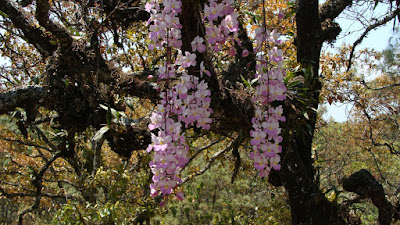Cuitlauzina pendula is native to Western Mexico. They grows on trees in oak or pine forests, in the coastal mountains surrounding the Balsas Basin over the Pacific Ocean. These plants are also found near Morelia and Talpa in the states of Michoacan and Jalisco, usually at heights of 1400-2200 m...
Cuitlauzina pendula also called as The Pendant Cuitlauzina, Cuitlauzina pendula f. rosella, Leochilus dignathe, Lichterveldia lindleyi, Odontoglossum citrosmum, Odontoglossum pendulum, Oncidium citrosmum, Oncidium galeottianum, is a species of the genus Cuitlauzina. This species was described by Juan José Martinez de Lexarza in 1825.
IDENTIFY CUITLAUZINA PENDULA
Cuitlauzina pendula is native to Western Mexico. They grows on trees in oak or pine forests, in the coastal mountains surrounding the Balsas Basin over the Pacific Ocean. These plants are also found near Morelia and Talpa in the states of Michoacan and Jalisco, usually at heights of 1400-2200 m. There are also reports of their occurrence in the states of Sinaloa and Guerrero, and not very certain reports from the states of Mexico, Oaxaca and Chiapas.
It is a small to medium sized, cool to cold growing epiphyte and sometime terrestrial, which reaching 38 cm in height, with a short rhizome carrying ovoid, clustered, compressed, ancipitous, dull or glossy light green, sulcate with age, up to 8 cm tall pseudobulbs carrying 2 apical, coriaceous, broadly ligulate, acute or obtuse, coriaceous, 30 cm long leaves.
The Pendant Cuitlauzina blooms in the late spring and fall on an axillary, pendant, to 30 cm long, cylindrical, several flowered, racemose inflorescence arising vertically out of a newly formed pseudobulb leaf sheath, with the lemon-scented, waxy, long-lived flowers clustered towards the apex. The flowers open completely and are about 5 cm in diameter and wide, rounded petals of both whorls. They are usually white but may have pale pink streaks or spots. The kidney lip has a color from pale to bright pink and has a bright yellow tooth at the base.
CUITLAUZINA PENDULA CARE AND CULTURE
Cultural information should only be used as a guide, and should be to be adapted to suit you. Your physical location; where you grow your plants, how much time you have to devote to their care, and many other factors, will need to be taken into account. Only then can you decide on the cultural methods that best suit you and your plants.
Light:
Cuitlauzina pendula needs a light level of 25000-35000 lux. During the brightest days, the plants should be slightly shaded. The level of light in the winter rest period should be as high as possible, so as not to burn the leaves. The plants thrive when sometimes exposed to direct sunlight. Constant, strong air movement is required.
Temperature:
The average temperature of the summer day is 25-28 ° C, night 14 ° C, giving a daily difference of 12-14 ° C. In spring, the average day temperature is 29-30 ° C, the night 11-13 ° C, giving a daily difference of 17-18 ° C. In winter the average day temperature is 23-25 ° C, the night 6-7 ° C, giving a daily difference of 17-18 ° C.
Humidity:
The Pendant Cuitlauzina needs the humidity of probably around 75% in summer, and in winter and spring falls to 50-60%.
Substrate, growing media and repotting:
Cuitlauzina pendula can be mounted on cork or tree fern rootstock if high humidity and watering are maintained at least once a day during the summer. When growing in pots, a loose and airy substrate such as bark of medium or large size, pieces of cork or tree-fern fiber is recommended. The pots should be as small as possible so that only the root ball can fit. Repotting is best done at the end of winter, just before the emergence of new increments, or immediately after flowering.
Watering:
Precipitation is slight to moderate during the 5 months of the summer rainy season. Then immediately follows a period of 7 months of very dry season, lasting from autumn until late spring. In cultivation, the plants should lightly dry between watering even during active growth. When new growths reach maturity in autumn, the amount of water should be reduced.
Fertilizer:
During the active growth, the plants should be fertilized every week 1/4-1/2 of the recommended dose of fertilizer for orchids. You can use balanced fertilizer throughout the year or also can use high-nitrogen fertilizer from spring to mid-summer, and then at the end of summer and autumn, highly phosphoric fertilizer.
Rest period:
During the 7 months of winter months, water should be virtually eliminated. Cuitlauzina pendula can be irrigated only enough to protect them from being completely dry. This may be occasional fogging in the early morning, and watering only when the pseudobulbs are wrinkling excessively or the leaves hang down losing the turgor. When reducing the amount of water, fertilization should be eliminated.















COMMENTS